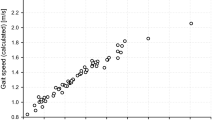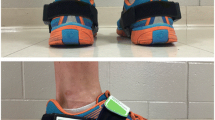Abstract
It is established that the ratio between step length (SL) and step frequency (SF) is constant over a large range of walking speed. However, few data are available about the spontaneous variability of this ratio during unconstrained outdoor walking, in particular over a sufficient number of steps. The purpose of the present study was to assess the inter- and intra-subject variability of spatio-temporal gait characteristics [SL, SF and walk ratio (WR=SL/SF)] while walking at different freely selected speeds. Twelve healthy subjects walked three times along a 100-m athletic track at: (1) a slower than preferred speed, (2) preferred speed and (3) a faster than preferred speed. Two professional GPS receivers providing 3D positions assessed the walking speed and SF with high precision (less than 0.5% error). Intra-subject variability was calculated as the variation among eight consecutive 5-s samples. WR was found to be constant at preferred and fast speeds [0.41 (0.04) m·s and 0.41 (0.05) m·s respectively] but was higher at slow speeds [0.44 (0.05) m·s]. In other words, between slow and preferred speed, the speed increase was mediated more by a change in SF than SL. The intra-subject variability of WR was low under preferred [CV, coefficient of variation = 1.9 (0.6)%] and fast [CV=1.8 (0.5)%] speed conditions, but higher under low speed condition [CV=4.1 (1.5)%]. On the other hand, the inter-subject variability of WR was 11%, 10% and 12% at slow, preferred and fast walking speeds respectively. It is concluded that the GPS method is able to capture basic gait parameters over a short period of time (5 s). A specific gait pattern for slow walking was observed. Furthermore, it seems that the walking patterns in free-living conditions exhibit low intra-individual variability, but that there is substantial variability between subjects.





Similar content being viewed by others
References
Bertram JE, Ruina A (2000) Multiple walking speed-frequency relations are predicted by constrained optimization. J Theor Biol 21:445–553
Grieve DW, Gear RJ (1966) The relationships between length of stride, step frequency, time of swing and speed of walking for children and adults. Ergonomics 9:379–399
Hausdorff JM, Peng CK, Ladin Z, Wei JY, Goldberger AL (1995) Is walking a random walk? Evidence for long-range correlations in stride interval of human gait. J Appl Physiol 78:349–358
Hausdorff JM, Purdon PL, Peng CK, Ladin Z, Wei JY, Goldberger AL (1996) Fractal dynamics of human gait: stability of long-range correlations in stride interval fluctuations. J Appl Physiol 80:1448–1457
Hausdorff JM, Cudkowicz ME, Firtion R, Wei JY, Goldberger AL (1998) Gait variability and basal ganglia disorders: stride-to-stride variations of gait cycle timing in Parkinson's disease and Huntington's disease. Mov Disord 13:428–437
Hausdorff JM, Zemany L, Peng C, Goldberger AL (1999) Maturation of gait dynamics: stride-to-stride variability and its temporal organization in children. J Appl Physiol 86:1040–1047
Hausdorff JM, Nelson ME, Kaliton D, Layne JE, Bernstein MJ, Nuernberger A, Singh MA (2001a) Etiology and modification of gait instability in older adults: a randomized controlled trial of exercise. J Appl Physiol 90:2117–2129
Hausdorff JM, Rios DA, Edelberg HK (2001b) Gait variability and fall risk in community-living older adults: a 1-year prospective study. Arch Phys Med Rehabil 82:1050–1056
Hirasaki E, Moore ST, Raphan T, Cohen B (1999) Effects of walking velocity on vertical head and body movements during locomotion. Exp Brain Res 127:117–130
Holt KG, Jeng SF, Ratcliffe R (1995) Energetic cost and stability during human walking at the preferred stride frequency. J Mot Behavior 27:164–178
Kurosawa K (1994) Effects of various walking speeds on probe reaction time during treadmill walking. Percept Mot Skills 78:768–770
Minetti AE, Capelli C, Zamparo P, di Prampero PE, Saibene F (1995) Effects of stride frequency on mechanical power and energy expenditure of walking. Med Sci Sports Exerc 27:1194–1202
Nagasaki H, Itoh H, Hashizume K, Furuna T, Maruyama H, Kinugasa T (1996) Walking patterns and finger rhythm of older adults. Percept Mot Skills 82:435–447
Perrin O, Terrier P, Ladetto Q, Merminod B, Schutz Y (2000) Improvement of walking speed prediction by accelerometry and altimetry, validated by satellite positioning. Med Biol Eng Comput 38:164–168
Sekiya N, Nagasaki H (1998) Reproducibility of the walking patterns of normal young adults: test-retest reliability of the walk ratio (step-length/step-rate). Gait Posture 7:225–227
Sekiya N, Nagasaki H, Ito H, Furuna T (1996) The invariant relationship between step length and step rate during free walking. J Hum Mov Stud 30:241–257
Terrier P, Ladetto Q, Merminod B, Schutz Y (2000) High-precision satellite positioning system as a new tool to study the biomechanics of human locomotion. J Biomech 33:1717–1722
Terrier P, Ladetto Q, Merminod B, Schutz Y (2001) Measurement of the mechanical power of walking by satellite positioning system (GPS). Med Sci Sports Exerc 33:1912–1918
Zarrugh MY, Todd FN, Ralston HJ (1974) Optimization of energy expenditure during level walking. Eur J Appl Physiol 33:293–306
Zarrugh MY, Radcliffe CW (1978) Predicting metabolic cost of level walking. Eur J Appl Physiol 38:215–223
Acknowledgements
The authors would like to thank Geoastor (Rümlang, Switzerland) for the loan of the Javad GPS receivers and the Laboratory of Topometry (Swiss Institute of Technology, Lausanne) for providing some technical help with the GPS technology. This study was partially supported by a grant of the Swiss Sciences Research Foundation (grant 3200–055928.98/1).
Author information
Authors and Affiliations
Corresponding author
Rights and permissions
About this article
Cite this article
Terrier, P., Schutz, Y. Variability of gait patterns during unconstrained walking assessed by satellite positioning (GPS). Eur J Appl Physiol 90, 554–561 (2003). https://doi.org/10.1007/s00421-003-0906-3
Accepted:
Published:
Issue Date:
DOI: https://doi.org/10.1007/s00421-003-0906-3




